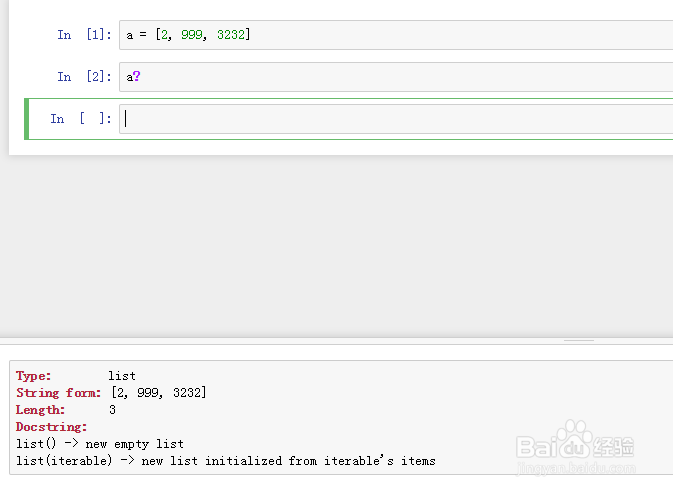如何运用JUPYTER NOTEBOOK的问号
1、打开JUPYTER NOTEBOOK,新建一个空白的PY文档。

2、a = [2, 999, 3232]
a?
Type: listString form: [2, 999, 3232]Length: 3Docstring: list() -> new empty listlist(iterable) -> new list initialized from iterable's items
定义一个列表,列表加上问号,可以查看这个列表的详情。

3、?a
如果把问号放在前面也是一样的,根据个人习惯定义即可。

4、print?
Docstring:print(value, ..., sep=' ', end='\n', file=sys.stdout, flush=False)Prints the values to a stream, or to sys.stdout by default.Optional keyword arguments:file: a file-like object (stream); defaults to the current sys.stdout.sep: string inserted between values, default a space.end: string appended after the last value, default a newline.flush: whether to forcibly flush the stream.Type: builtin_function_or_method
print是自带的function,也是可以用?查看用法。

5、def plus(x, y):
'plus 2 numbers together'
return x * y
plus?
Signature: plus(x, y)Docstring: plus 2 numbers togetherFile: c:\users\danson\desktop\<ipython-input-20-e41ef1d43fd2>Type: function
定义一个函数,也是可以查看该函数的信息。

6、plus??
Signature: plus(x, y)Source: def plus(x, y): 'plus 2 numbers together' return x * yFile: c:\users\danson\desktop\<ipython-input-20-e41ef1d43fd2>Type: function
如果要更具体的信息,可以加两个问号,对于长篇的编程来看,也是非常方便就可以查看函数的。

7、oo = {'a': 332, 'b': 32423, 'c':1231}
oo?
Type: dictString form: {'a': 332, 'b': 32423, 'c': 1231}Length: 3Docstring: dict() -> new empty dictionarydict(mapping) -> new dictionary initialized from a mapping object's (key, value) pairsdict(iterable) -> new dictionary initialized as if via: d = {} for k, v in iterable: d[k] = vdict(**kwargs) -> new dictionary initialized with the name=value pairs in the keyword argument list. For example: dict(one=1, two=2)
字典和列表一样,也是可以查看调用的。

8、pp = (3, 1, 5, 0)
pp?
Type: tupleString form: (3, 1, 5, 0)Length: 4Docstring: tuple() -> empty tupletuple(iterable) -> tuple initialized from iterable's itemsIf the argument is a tuple, the return value is the same object.
数组当然和列表和字典是一样可以这么操作查看的。
